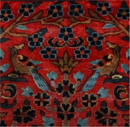< Back to
Carpets & Rugs
< Previous
Next >
Attributing Antique Oriental Rugs - Essential Reference Books
שטיחים עתיקים שגילם 80 שנים ומעלה הופכים להיות נדירים יותר ויותר. מרבית השטיחים המיוחדים והעתיקים שיוצרו בעבודת יד ובטכניקות אריגה וצביעה יחודיות בסוף המאה ה-19 ובתחילת המאה ה-20 באיזורי פרס, טורקמניסטאן ומרכז אסיה נעלמו מן השווקים. גם הידע וההבנה בשטיחים מהתקופה הזאת נעלמו מן השווקים. סוחרי השטיחים בני זמנינו עוסקים בעיקר ביבוא של שטיחים חדשים, לעיתים באיכות נמוכה, המיוצרים במזרח ומנסים לחקות את הדוגמאות והדגמים של העבר. מעטים מן העוסקים בשטיחים כיום מבינים במקורות השטיחים העתיקים, טכניקות האריגה והצביעה והדוגמאות המיוחדות המאפיינות את יצירות האמנות הללו. די נפוץ לשמוע דעות שונות, לעיתים סותרות, בקשר למקורו ולגילו של שטיח, הכל בהתאם לנקודת המבט והכדאיות של המומחה. הספרים המוצגים כאן הם נכס הכרחי בארגז הכלים של אספן שטיחים עתיקים מהמזרח שמנסה לאפיין את מקורו, גילו והרקע התרבותי של שטיח אספנות הנקרה בדרכו.
These are the books I use when I wish to attribute an authentic oriental rug - the first rug books to check when I see a type of an antique rug or carpet which I am not familiar with. These books are meant for the individual who is interested in purchasing antique oriental rug as well as for the collector who would like to enhance his understanding in oriental rugs and carpets. Together they serve as a comprehensive suite of reference books for distinguishing antique oriental rugs.
***
Oriental Rugs Antique & Modern by Walter A. Hawley
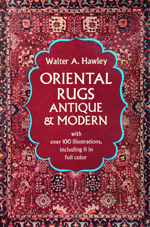
Antique Oriental carpets and rugs has long been valued as works of art and fine examples are to be seen in museums and private collections throughout the world. These designs have been handled down from generation to generation of craftsmen, but antique carpets made by the traditional methods are getting rare. For the past hundred years, and possible longer, one of the treasures of collectors' art world has been the authentic hand made oriental carpet, imported from Turkey, Persia, central Asia or even occasionally from China. Walter Augustus Hawley - Oriental Rugs Antique & Modern has been regarded for almost hundred years (since it first date of publication in 1913) as the best resource for identifying these beautiful pieces of art.
It tells you almost everything you need to know about antique orient rugs: the history of rug-making in the Near East, with its cultural extensions; the materials used, how prepared and dyed; the various knots that are used to fasten the pile and their significance for identifying carpets; the remarkable designs and symbols, and their meaning; the techniques used in making the carpet; and the determination of aniline-dyed imitations. Most of this information has been carefully guarded secret trade lore of the dealers.
Hawley covers in detail the rug from each of the six major groups: Turkish, Caucasian, Persian, Indian, Central Asiatic (AKA Turkmen) and Chinese. He describes the special features of each: size, color, patterns, symbols, fringes, weaving and knotting techniques, as well as the wealth of the lore associated with each. This material is presented so clearly that you should be able to identify with accuracy any true oriental rug that you are likely to see - I extensively use Chapter 16 - "how to distinguish rugs?" when I meet a type of an oriental rug or carpet which I am not familiar with.
Paperback: 320 pages of text
with over 100 illustrations including 11 in full color
Publisher: Dover Publications (1970); unabridged republication of the work
originally published by John Lane Company in 1913
Language: English
ISBN-10: 0486223663
ISBN-13: 9780486223667
Have a Comment? Call
***
Oriental Rugs - a Complete Guide by Charles W. Jacobsen
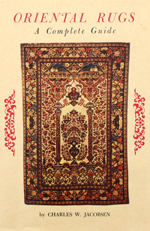
An excellent resource for basic information on antique oriental rugs and rug terms based on a work written by Charles W Jacobsen in 1931.
The first part devotes one chapter to each of the
large rug weaving countries and includes helpful hints as to what the collector
should look for in any particular rug, the quality of weaving and what the collector
might expect from that rug in terms of durability.
Part two is an alphabetical list of all the names that have been used to identify
rugs in the past as well as the names that are being used at the date of publication
(1962). The characteristics of each rug are outlined, making it possible for the
collector to readily identify each type of rug. The author draws from his experience
to relate past findings, good and bad, concerning the different types.
Part three contains 194 pictures of different types of rugs complete with descriptive
captions for each. Thirty nine of the plates are in full color. The book has already
been acclaimed by experts as: "The most comprehensive book ever published on oriental
rugs". For me - this work is certain to be the standard book on the subject for
many years and a great helper in understanding the
Turkmen Rugs terminology.
Hardcover: 479 pages, 194 pictures including
39 in full color
Publisher: Tuttle Publishing (1970); first edition 1962
Language: English
ISBN-10: 0804804516
ISBN-13: 9780804804516
Have a Comment? Call
***
Oriental Rugs - Volume 3 - The Carpets of Afghanistan by R.D. Parsons
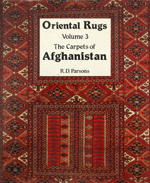
The first definitive work on Afghan production, in which rugs made in the past half of the 20th century or so are given locations and ascribed to groups of weavers, this book has proved an essential work of reference. Published in a revised edition, it will guide the keen collector and the first-time buyer through a labyrinth of fascinating choices.
Author Richard Parsons, for many years buyer in
Afghanistan for the well-known firm O.C.M. (London) Ltd., treats the reader to
not only a veritable feast of carpets and rugs, all with their attendant tribal
origins and motifs vividly explained, but also to a fascinating journey through
the history of a diverse, colourful, multiracial country.
The author shares his respect and admiration for Afghanistan's stoic people, who
somehow despite political upheavals, forced resettlement, a harsh climate, and
often primitive nomadic living conditions, manage to fashion exquisite works of
art, which reflect their pride in their many-faceted heritage. Afghan rugs,
which are instantly appealing due to their traditional colors and bold designs,
open up a whole new vista for the collector, from sumptuous piled purdahs to
flat woven prayer rugs.
Hardcover: 157 pages, 114 color illustrations 90 black and white
illustrations
Publisher: Antique Collector's Club; Revised edition 1987
Language: English
ISBN-10: 1851490582
ISBN-13: 9781851490585
Have a Comment? Call
***
Modern Oriental Carpets by E. Gans-Ruedin
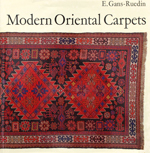
Modern Oriental Carpets is a compressive study especially valuable as it concentrates on carpets which were available at the time the book was published (1970) and are now considered as antique rug and carpets and are of great importance to antique rug collectors.
Nearly two hundred individual designs are described in detail, and the information has been gathered by the author, and the photographs taken in the carpet-producing countries themselves. The carpets are classified by area or village under country or in the case of Iran, under the main regions. Each type is illustrated by at least one high quality reproduction, with captions giving details of origins, techniques, design and colors. The key countries of Iran and Turkey are given due prominence, but the production of carpets in Afghanistan, Turkestan, Pakistan, Tibet, China, North Africa and Balkan countries is also fully surveyed.
The explanations of motifs and other information has been verified by the author in numerous visits to the places concerned, often remote and out-of-the-way villages far from the main centers of communication. The main section of the book is preceded by historical introduction and by notes on every aspect of the oriental carpet: materials, dyeing, designs, weaving and knotting, the carpet trade, buying, conversations and restorations.
For the general reader, the book gives an informed look on a fascinating subject, combined with wealth of beautiful illustrations. For the connoisseur and collector, it is an invaluable work of reference, providing a comprehensive guide to the designs that were available at the time of publishing.
Many works on the history of Oriental carpets show examples preserved in museums or in great private collections; and from these, the keen collector can learn a great deal. The Modern Oriental Carpets by E. Gans-Ruedin which is intended for the general public, takes another approach. After an historical account and several general chapters devoted to the technical or symbolic characteristics of carpets, the author deals with the essential and strictly original part of his study; he establishes a detailed classification by country, and in case of Iran, by regions: each example is illustrated by one or several annotated reproductions. The lesser known products of countries such as Pakistan, India, Tibet, China, North Africa and Balkan countries also figure in this vast panorama, so that nothing is omitted from the vary wide currently on the market of antique rugs and carpets.
The collector will be able to form a precise opinion on the rugs which he will have the opportunity to see, owning the wealth of information provided on the origin, technique, style of patterns, coloring, and finally the quality of each example. This information, the result of a lengthy experience, has all been verified on the spot by the author, during frequent journeys in the producing countries. Indeed, the description of motifs is as complete as possible, but is often extremely difficult to obtain, even from the rug makers themselves, a comprehensive explanations of their designs; they use such and such motif in accordance with tradition, but they are no longer aware of its original meaning.
Another difficulty in getting information first hand lies in the inaccessibility of many villages. It can happen that in a town which deals daily with one type of carpet, no body can tell you where the producing villages are, even though they might be less than 40 miles away. This is because the dealers have never been there, the villagers themselves, arranging to bring their products into town. If you insist on making for one of these villages, nobody can understand your interest: why should you wish to undertake an uncomfortable journey, at all costs, since the local output is on sale in the market of the town? For me the answer is straightforward - to see the beauty in vivo - I wish I could have been there.
Hardcover: 431 pages, 466 illustrations
including 42 in color and 4 maps
Publisher: Thames & Hudson Ltd (1971); translated from French: Connaissance
du Tapis by Valerie Howard
Language: English
ISBN-10: 0500231559
ISBN-13: 9780500231555
Have a Comment? Call
Item: B1011 - Oriental Rugs EssentialsFind more rare books about Antique Oriental Carpets and Rugs
© Dan Levy - Art Pane Home of Antique Oriental Carpets and Rugs
< Back to
Carpets & Rugs
< Previous
Next >
